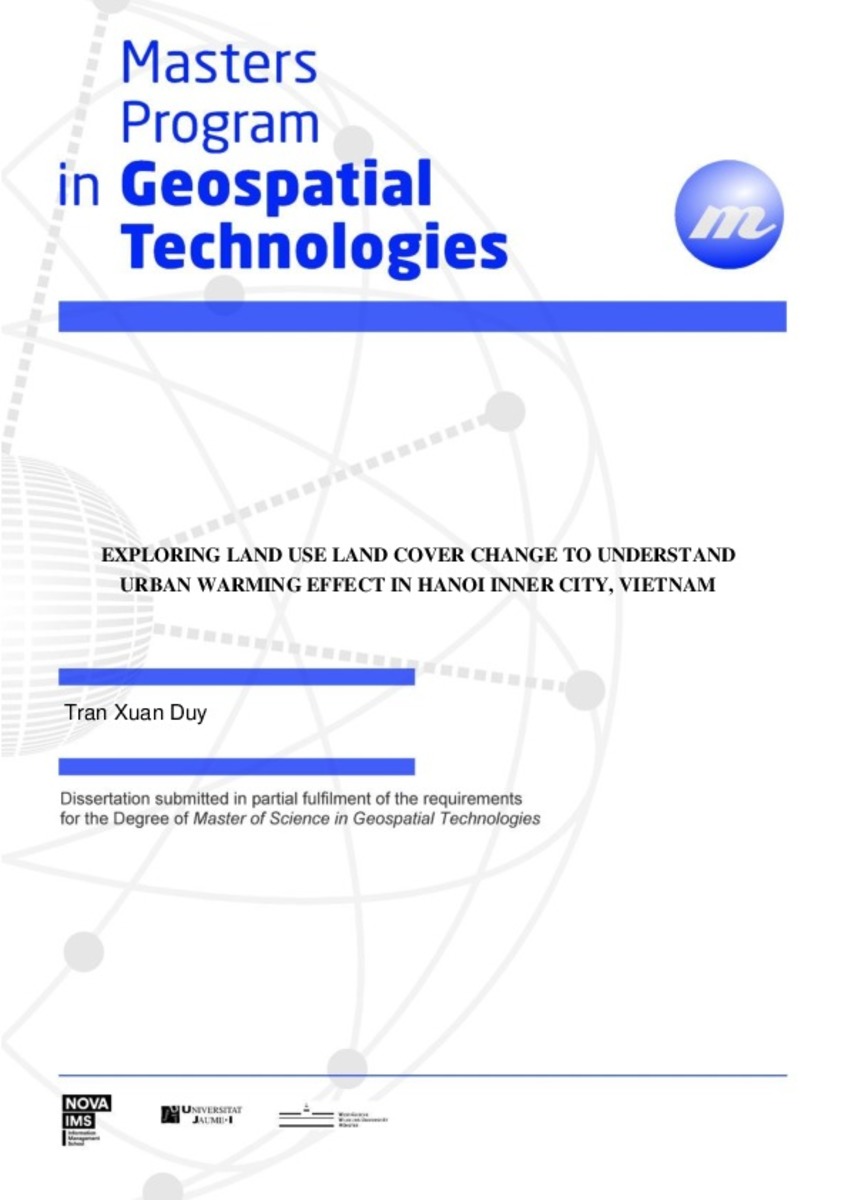Mostrar el registro sencillo del ítem
Exploring land use land cover change to understand urban warming effect in Hanoi Inner City, Vietnam
| dc.contributor | Pla Bañón, Filiberto | |
| dc.contributor | Myint, Soe W. | |
| dc.contributor | Caetano, Mário | |
| dc.contributor.author | Tran, Xuan Duy | |
| dc.contributor.other | Universitat Jaume I. Departament de Llenguatges i Sistemes Informàtics | |
| dc.date.accessioned | 2016-06-21T08:34:55Z | |
| dc.date.available | 2016-06-21T08:34:55Z | |
| dc.date.issued | 2016-03-07 | |
| dc.identifier.uri | http://hdl.handle.net/10234/160931 | |
| dc.description | Treball final de Màster Universitari Erasmus Mundus en Tecnologia Geoespacial. Codi: SIW013. Curs academic 2015-2016 | ca_CA |
| dc.description.abstract | Recently, urbanization is occurring rapidly in Hanoi, the second largest city in Vietnam. The process is profoundly reflected in Hanoi inner city where the socio-economic development is faster than in other areas. This has led to the acquisition of agricultural land that in turn, has resulted in land use changes, and subsequently increasing the residential, commercial and industrial land. The transformation between different land use types especially the urban expansion will crucially influence the land surface temperature pattern (LST). This will severely affect to the community in relation to people’s health and energy consumption. Exploring land use land cover (LULC) change to understand urban warming effect is a necessary work for community and local government. The research can be used as a scientific basis for urban planners in urban planning and management as well as to increase the community awareness in urban warming effect. The purpose of this research is to determine and analyze the relationship between LULC change and LST pattern. To achieve the research goal, we need to accomplish a series of specific objectives. First, we perform supervised maximum likelihood classification method and change detection to determine the patterns and rate of change, and land cover and land use transformation within and around Hanoi inner city. Then we explore the relationship between land surface temperature and a) vegetation, b) man-made features, and c) crops land using normalized vegetation, and built-up indices within each LULC type. After that, we employ a Markov chains model to simulate future LULC change using different environmental and planning scenarios. Finally, we apply linear and non- linear regression to predict future urban climate patterns in Hanoi inner city using the predicted land cover and land use change. | ca_CA |
| dc.format.extent | viii, 54 p. | ca_CA |
| dc.format.mimetype | application/pdf | ca_CA |
| dc.language.iso | eng | ca_CA |
| dc.publisher | Universitat Jaume I | ca_CA |
| dc.rights | Attribution-NonCommercial-ShareAlike 4.0 Spain | * |
| dc.rights.uri | http://creativecommons.org/licenses/by-nc-sa/4.0/ | * |
| dc.subject | Màster Universitari Erasmus Mundus en Tecnologia Geoespacial | ca_CA |
| dc.subject | Erasmus Mundus University Master's Degree in Geospatial Technologies | ca_CA |
| dc.subject | Máster Universitario Erasmus Mundus en Tecnología Geoespacial | ca_CA |
| dc.subject | Land use land cover | ca_CA |
| dc.subject | Urban heat island | ca_CA |
| dc.subject | Regression analysis | ca_CA |
| dc.subject | Landsat | ca_CA |
| dc.subject | Remote sensing | ca_CA |
| dc.subject | Geographical Information Systems | ca_CA |
| dc.subject | Spatial analysis | ca_CA |
| dc.title | Exploring land use land cover change to understand urban warming effect in Hanoi Inner City, Vietnam | ca_CA |
| dc.type | info:eu-repo/semantics/masterThesis | ca_CA |
| dc.educationLevel | Estudios de Postgrado | ca_CA |
| dc.rights.accessRights | info:eu-repo/semantics/openAccess | ca_CA |
Ficheros en el ítem
Este ítem aparece en la(s) siguiente(s) colección(ones)
-
TFM: Màster Universitari Erasmus Mundus en Tecnologia Geoespacial [79]
SIW013; SIK013








